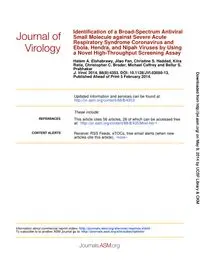
2014 Identification of a Broad-Spectrum Antiviral Small Molecule against Severe Acute Respiratory Syndrome Coronavirus a PDF
Preview 2014 Identification of a Broad-Spectrum Antiviral Small Molecule against Severe Acute Respiratory Syndrome Coronavirus a
Published Ahead of Print 5 February 2014. 2014, 88(8):4353. DOI: 10.1128/JVI.03050-13. J. Virol. Prabhakar Ratia, Christopher C. Broder, Michael Caffrey and Bellur S. Hatem A. Elshabrawy, Jilao Fan, Christine S. Haddad, Kiira a Novel High-Throughput Screening Assay Ebola, Hendra, and Nipah Viruses by Using Respiratory Syndrome Coronavirus and Small Molecule against Severe Acute Identification of a Broad-Spectrum Antiviral http://jvi.asm.org/content/88/8/4353 Updated information and services can be found at: These include: REFERENCES http://jvi.asm.org/content/88/8/4353#ref-list-1 at: This article cites 56 articles, 26 of which can be accessed free CONTENT ALERTS more» articles cite this article), Receive: RSS Feeds, eTOCs, free email alerts (when new http://journals.asm.org/site/misc/reprints.xhtml Information about commercial reprint orders: http://journals.asm.org/site/subscriptions/ To subscribe to to another ASM Journal go to: on May 9, 2014 by UCSF Library & CKM http://jvi.asm.org/ Downloaded from on May 9, 2014 by UCSF Library & CKM http://jvi.asm.org/ Downloaded from Identification of a Broad-Spectrum Antiviral Small Molecule against Severe Acute Respiratory Syndrome Coronavirus and Ebola, Hendra, and Nipah Viruses by Using a Novel High-Throughput Screening Assay Hatem A. Elshabrawy,a,e* Jilao Fan,a Christine S. Haddad,a Kiira Ratia,b Christopher C. Broder,c Michael Caffrey,d Bellur S. Prabhakara Department of Microbiology and Immunology, College of Medicine, University of Illinois at Chicago, Chicago, Illinois, USAa; University of Illinois at Chicago Research Resources Center, Chicago, Illinois, USAb; Department of Microbiology and Immunology, Uniformed Services University, Bethesda, Maryland, USAc; Department of Biochemistry and Molecular Genetics, College of Medicine, University of Illinois at Chicago, Chicago, Illinois, USAd; Cairo University, Cairo, Egypte ABSTRACT Severe acute respiratory syndrome coronavirus (SARS-CoV) and Ebola, Hendra, and Nipah viruses are members of different viral families and are known causative agents of fatal viral diseases. These viruses depend on cathepsin L for entry into their tar- get cells. The viral glycoproteins need to be primed by protease cleavage, rendering them active for fusion with the host cell membrane. In this study, we developed a novel high-throughput screening assay based on peptides, derived from the glycopro- teins of the aforementioned viruses, which contain the cathepsin L cleavage site. We screened a library of 5,000 small molecules and discovered a small molecule that can inhibit the cathepsin L cleavage of all viral peptides with minimal inhibition of cleavage of a host protein-derived peptide (pro-neuropeptide Y). The small molecule inhibited the entry of all pseudotyped viruses in vitro and the cleavage of SARS-CoV spike glycoprotein in an in vitro cleavage assay. In addition, the Hendra and Nipah virus fusion glycoproteins were not cleaved in the presence of the small molecule in a cell-based cleavage assay. Furthermore, we dem- onstrate that the small molecule is a mixed inhibitor of cathepsin L. Our broad-spectrum antiviral small molecule appears to be an ideal candidate for future optimization and development into a potent antiviral against SARS-CoV and Ebola, Hendra, and Nipah viruses. IMPORTANCE We developed a novel high-throughput screening assay to identify small molecules that can prevent cathepsin L cleavage of viral glycoproteins derived from SARS-CoV and Ebola, Hendra, and Nipah viruses that are required for their entry into the host cell. We identified a novel broad-spectrum small molecule that could block cathepsin L-mediated cleavage and thus inhibit the entry of pseudotypes bearing the glycoprotein derived from SARS-CoV or Ebola, Hendra, or Nipah virus. The small molecule can be further optimized and developed into a potent broad-spectrum antiviral drug. S evere acute respiratory syndrome coronavirus (SARS-CoV), Ebola virus (EBOV), Hendra virus (HeV), and Nipah virus (NiV) are highly infectious zoonotic viruses, with various species of bat as the identified natural reservoir (1–6), and are the caus- ative agents of severe acute respiratory syndrome (7), severe acute hemorrhagic fever (EBOV) (8), and fatal encephalitis (HeV and NiV) (9, 10). Enveloped viruses enter their target cells by fusion of the viral envelope with the host cell membrane, delivering the viral genome to the cytoplasm (11). SARS-CoV, the Middle East respiratory syndrome coronavirus (MERS-CoV), EBOV, HeV, and NiV are enveloped viruses that critically require cathepsin L (CatL), a host intracellular lysosomal protease, for their glycoprotein processing and cleavage, which are required for virus fusion and entry into the host cells (12–16). SARS-CoV and EBOV infect the target cells after cleavage of their fusion glycoproteins by CatL in the endo- cytic vesicles (14, 15). The fusion (F0) protein of HeV and NiV is translocated to the membrane during viral assembly and then in- ternalized, allowing for CatL-mediated cleavage into the F1 and F2 subunits. The processed F protein is then incorporated into the viral particle (12, 13). The high virulence of these viruses and the absence of effective therapies or vaccines pose an ongoing threat to the public health. Developing a broad-spectrum antiviral drug that can inhibit the aforementioned viral infections would repre- sent a first but potent step for the protection of the public. Antiviral drugs can be broadly divided into 4 major classes. One group consists of nucleoside analogs that interfere with rep- lication of the viral genome and includes the first successful anti- viral drug, acyclovir, which is effective against herpesvirus infec- tions and can delay HIV-1 progression (17–19). The first antiviral drug to be approved for treating HIV, zidovudine (AZT), is also a nucleoside analog that blocks reverse transcriptase (20). However, these nucleoside analogs can target only viruses that use their own polymerases for genome replication, such as HIV and herpesvi- ruses, as they have lower affinity to cellular DNA polymerase. Received 17 October 2013 Accepted 22 January 2014 Published ahead of print 5 February 2014 Editor: S. Lo´pez Address correspondence to Bellur S. Prabhakar,
